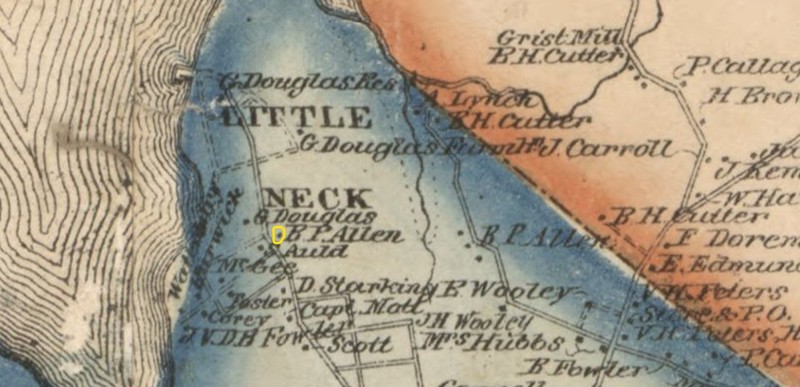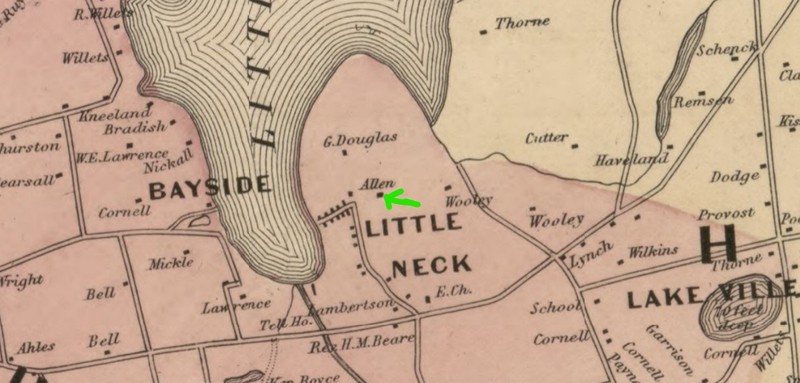Allen-Beville House
Introduction
Text-to-speech Audio
The wood frame house on Center Drive south of the intersection with Forest Rd. is the Allen-Beville House, one of the oldest surviving nineteenth-century farmhouses in Queens. The home was built by farmer Benjamin P. Allen in the late 1840s or early 1850s. William Douglas bought the house from the Allen estate in the late nineteenth century and probably used the building as one of the guest houses for his nearby estate; the new name for Little Neck, Douglaston, came from William. The Bevilles purchased the house in 1946.The Allen-Beville House is a National Register listing (1983) and a New York City landmark (1977). The house is one of hundreds of homes within the Douglaston National Register Historic District.
Images
View of front of Allen-Beville House in 2013 (Peter Greenberg)

Allen-Beville House (yellow circle) in Little Neck on 1859 map (Walling)

Allen-Beville House (green arrow) on 1860 map (Higginson)

Allen-Beville House (blue circle) on 1886 map (Beers)

Backstory and Context
Text-to-speech Audio
Benjamin P. Allen (born 1819 - died 1893) was the son of Philip Allen (1780 - 1829) and Eliza Treadwell Platt Allen (1788 - 1862). Benjamin P. bought the land in 1847 and is thought to have built the farmhouse soon afterwards. In 1853, Benjamin P. married Catherine Cornell Bergen (1832- 1898).
Benjamin Allen served as a vestryman for the local Zion Episcopal Church from 1866 to 1883. The church was founded in 1830 by about 17 men, including neighbor Wynant Van Zandt; the church stood where a new church took its place, off of Northern Blvd, after the original church burned down in 1924. Benjamin is buried in the church's cemetery, along with his widow, Catherine, and his son, Philip Allen (1857 - 1919).
In 1850, Benjamin P. Allen was a 37-year-old farmer and head of a household in Flushing Township that included his widowed mother Eliza (age 60). The other four residents of the home appear to be servants and farmhands: Ann Hancy (22, born in Ireland); William Smith (14, born in New York); Owen Scott (23, laborer, born in Ireland); and James Billion (19, African-American laborer, born in New York); Hancy and Scott were both illiterate. Benjamin P.'s real estate was valued at $1.500; this may reflect his purchase of the land in 1847 but seems too low to include the house. Perhaps the house was not yet built in 1850 and Benjamin P. still lived in his parents' home. By 1860, when Benjamin P. was almost certainly living in his new house, he resided with wife Catherine (30); sons Henry (4) and Philip (2); and daughter Jane (1). Two Irish-born laborers lived in the home: James Courtney (40) and Patrick Brennan (30); and a laborer born in New York named James Brennan (17). The farmer's real estate was valued at $20,000 in 1860, with $15,000 in personal items.
In 1865, Benjamin P. set aside space in his house for a school for the local community's children, according to the NYC landmark designation report. In 1870, Benjamin P. was a retired farmer and lived in the farmhouse with his wife and five children: Henry P. (14); Philip (12); Jane (10); Charles (8); and William O. (6). The Allens shared the home with four of their children by 1880: Philip (22); Jane (20); Charles (18); and William (15). One laborer, Walter Thompson (35) also lived in the farmhouse and worked on the farm, along with the Allen sons. Benjamin P. died in 1883.
In the early twentieth century, the house became part of a subdivision owned by the Douglas Manor Company. Anne R. Feddis purchased a number of lots in the subdivision, including the Allen-Beville House. The executors of the estate of Walter Scott Faddis sold the home to Alan Warner in 1945. Warner sold the home to Hugh and Eleanor Beville in 1946, who owned the home for many decades.
The symmetrical, Greek Revival style, rectangular house is covered in clapboard and is 2.5 stories over a low basement. The roof is topped by an octagonal cupola and the front and rear are spanned by porches with Doric columns. The single-family home last sold in 2006 for nearly $2.5 million.
Sources
Adair, Carl. About Us, Zion Episcopal Church. October 3rd 2019. Accessed June 29th 2022. https://zionepiscopal.org/about-us/history/.
Morris, Montrose. Allen-Beville House, Douglaston, forgotten new york. January 12th 2017. Accessed June 29th 2022. https://forgotten-ny.com/2017/01/allen-beville-house-douglaston/.
NYC Landmarks Preservation Commission. Designation Report, Allen-Beville House, 29 Center Drive, Douglaston, Borough of Queens. Volume LP-0944. NYC landmarks. New York, NY. New York City government, 1977.
SRK. Find A Grave Memorial for Benjamin P. Allen (1819-1883), Find A Grave. February 19th 2013. Accessed June 29th 2022. https://www.findagrave.com/memorial/105499585/benjamin-p-allen.
Street Easy. House: Allen-Beville House, 236-02 Forest Road, Little Neck, NY, 11363, StreetEasy. January 1st 2022. Accessed June 29th 2022. https://streeteasy.com/building/allen-beville-house.
U.S. Census Bureau. Household of Benjamin P. Allen in Town of Flushing, Queens County, New York, dwelling 209, family 215. Washington, DC. U.S. Government, 1850.
U.S. Census Bureau. Household of Benjamin P. Allen in Town of Flushing, Queens County, New York, dwelling 1303, family 1619. Washington, DC. U.S. Government, 1860.
U.S. Census Bureau. Household of Benjamin Allen in Town of Flushing, Queens County, New York, dwelling 843, family 923. Washington, DC. U.S. Government, 1870.
U.S. Census Bureau. Household of Benjamin Allen in Town of Flushing, Queens County, New York, dwelling 168, family 176. Washington, DC. U.S. Government, 1880.
https://en.wikipedia.org/wiki/Allen-Beville_House#/media/File:Allen-Beville_House.JPG
Library of Congress (LOC): https://www.loc.gov/item/2013593266/
LOC: https://www.loc.gov/item/2013593267/
LOC: https://www.loc.gov/item/2013593269/
